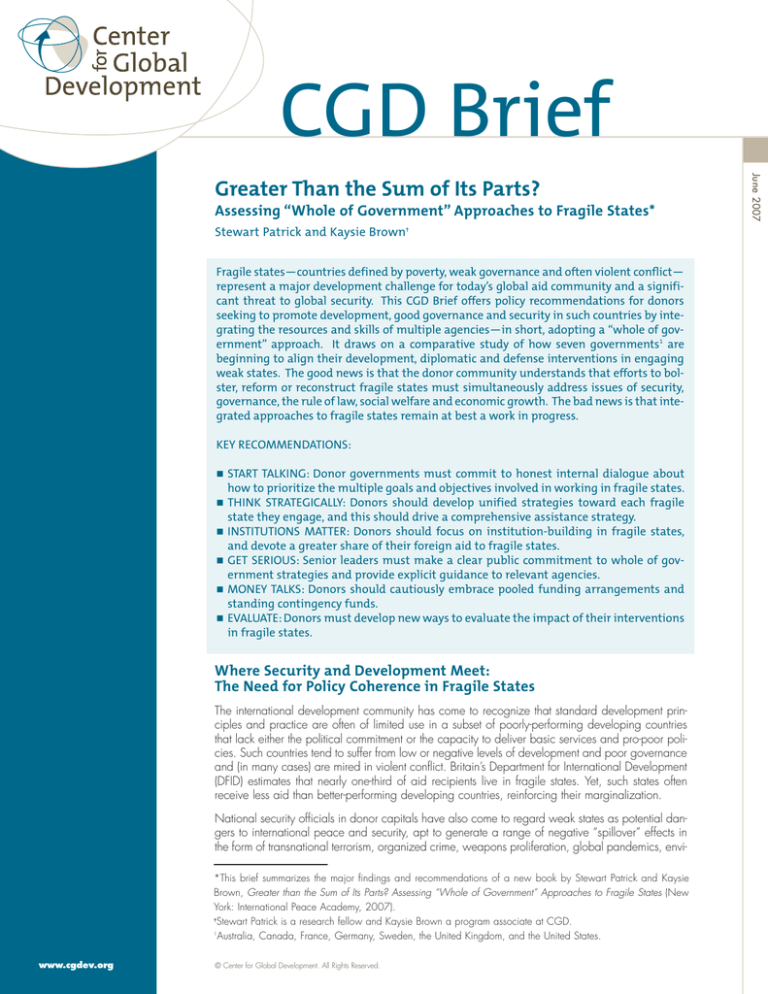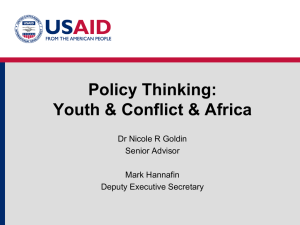
CGD Brief
Assessing “Whole of Government” Approaches to Fragile States*
Stewart Patrick and Kaysie Brown✝
Fragile states—countries defined by poverty, weak governance and often violent conflict—
represent a major development challenge for today’s global aid community and a significant threat to global security. This CGD Brief offers policy recommendations for donors
seeking to promote development, good governance and security in such countries by integrating the resources and skills of multiple agencies—in short, adopting a “whole of government” approach. It draws on a comparative study of how seven governments1 are
beginning to align their development, diplomatic and defense interventions in engaging
weak states. The good news is that the donor community understands that efforts to bolster, reform or reconstruct fragile states must simultaneously address issues of security,
governance, the rule of law, social welfare and economic growth. The bad news is that integrated approaches to fragile states remain at best a work in progress.
KEY RECOMMENDATIONS:
n START TALKING: Donor governments must commit to honest internal dialogue about
how to prioritize the multiple goals and objectives involved in working in fragile states.
n THINK STRATEGICALLY: Donors should develop unified strategies toward each fragile
state they engage, and this should drive a comprehensive assistance strategy.
n INSTITUTIONS MATTER: Donors should focus on institution-building in fragile states,
and devote a greater share of their foreign aid to fragile states.
n GET SERIOUS: Senior leaders must make a clear public commitment to whole of gov-
ernment strategies and provide explicit guidance to relevant agencies.
n MONEY TALKS: Donors should cautiously embrace pooled funding arrangements and
standing contingency funds.
n EVALUATE: Donors must develop new ways to evaluate the impact of their interventions
in fragile states.
Where Security and Development Meet:
The Need for Policy Coherence in Fragile States
The international development community has come to recognize that standard development principles and practice are often of limited use in a subset of poorly-performing developing countries
that lack either the political commitment or the capacity to deliver basic services and pro-poor policies. Such countries tend to suffer from low or negative levels of development and poor governance
and (in many cases) are mired in violent conflict. Britain’s Department for International Development
(DFID) estimates that nearly one-third of aid recipients live in fragile states. Yet, such states often
receive less aid than better-performing developing countries, reinforcing their marginalization.
National security officials in donor capitals have also come to regard weak states as potential dangers to international peace and security, apt to generate a range of negative “spillover” effects in
the form of transnational terrorism, organized crime, weapons proliferation, global pandemics, envi*This brief summarizes the major findings and recommendations of a new book by Stewart Patrick and Kaysie
Brown, Greater than the Sum of Its Parts? Assessing “Whole of Government” Approaches to Fragile States (New
York: International Peace Academy, 2007).
✝
Stewart Patrick is a research fellow and Kaysie Brown a program associate at CGD.
1
Australia, Canada, France, Germany, Sweden, the United Kingdom, and the United States.
www.cgdev.org
© Center for Global Development. All Rights Reserved.
June 2007
Greater Than the Sum of Its Parts?
Greater than the Sum of Its Parts? Assessing “Whole of Government” Approaches to Fragile States
2
ronmental degradation, and the spread of violent conflict. The
attacks on the United States of September 11, 2001, demonstrated the grievous damage terrorists operating from poor countries can inflict on even the world’s most powerful state.
Additionally, the difficulties in stabilizing and reconstructing wartorn countries, including Afghanistan, Iraq and Sudan, have led
donor governments to explore integrated approaches to postconflict operations.
The challenges of fragile states imply not only doing things differently but also doing different things. Effective donor responses may mean doing things outside traditional development
expertise and not covered under official development assistance (ODA)-eligible activities. This may involve collaboration
with non-development ministries with greater expertise and
resources (as well as a mandate) to address these tasks, such
as the disarmament of former combatants, police deployments,
transitional justice, and peace support activities.
Aware that building effective states in the developing world
requires addressing a slew of development, governance and
security concerns that are beyond the competence of any single agency, the donor community in April 2005 endorsed a
“whole of government” approach to fragile states. To this end,
several donors have drafted government- or agency-wide fragile state strategies, created dedicated units to integrate interdepartmental prevention or reconstruction efforts, and experimented with new funding arrangements to promote interdepartmental collaboration. Among them are Australia, Canada,
France, Germany, Sweden, the United Kingdom, and the
United States. What progress have they made in such “whole
of government” efforts in weak environments?
FINDING 1: THERE ARE VARYING OBJECTIVES AMONG
COUNTRIES AND WITHIN GOVERNMENTS
While all seven governments regard fragile states as both a
development and security challenge, they differ in the weight
they give them. Motivations and objectives fall along two
extremes: policy coherence for national security versus policy
coherence for development. For example, Sweden treats global development as the centerpiece of its international engagement. Conversely, the United States is motivated overwhelmingly by the global war on terrorism. France gives more
weight to national security, whereas the U.K., Canada,
Australia and Germany fall somewhere in the middle.
Within governments, there is even less coherence among agencies about what constitutes a fragile state, and no single donor
has formulated a government-wide fragile states strategy. The
concept is most popular among development ministries; foreign
and defense ministries tend to be more skeptical, finding the
term a distraction from concrete challenges of crisis response
and post-conflict reconstruction. This lack of a unified strategic
vision results in a welter of competing white papers and policy
statements from different agencies.
FINDING 2: FOR THE DEVELOPMENT COMMUNITY,
BENEFITS AND HAZARDS OF INTEGRATION
The development community remains deeply ambivalent about
whole of government approaches in fragile states. On the one
hand, the growing national security salience of fragile states
and the rise of interagency approaches can help to garner
political attention and additional aid resources for development programs. It can also allow development ministries to
leverage the contributions of defense and diplomatic actors to
address issues that may be outside the core competencies and
legal authorities of traditional aid agencies. But integrated
approaches also carry potential risks for development agencies. There are concerns that the core development agenda,
including poverty alleviation and long-term institution-building,
will be subordinated to more immediate security imperatives.
Even in countries with strong development agencies, like the
U.K. and Canada, there is increased pressure to fund either
non-traditional initiatives (in Canada’s case, the CounterTerrorism Capacity Building Program) or to label certain countries as fragile so as to give strategically important states development aid (in the case of the U.K., there has been pressure
for DFID to fund programmatic activities in Saudi Arabia).
FINDING 3: LACK OF LEADERSHIP AND COORDINATION
Unfortunately, none of the countries studied has demonstrated
high-level political support behind interagency approaches to
fragile states, nor have they been successful in developing robust
coordinating entities to address fragile states on a governmentwide level. In the U.K., the Cabinet Office, despite its placement
at the heart of government, is generally incapable of pushing
departments toward the pursuit of common strategic goals. In the
United States, the National Security Council has played a
remarkably hands-off role in coordinating the various agencies,
or in developing doctrine to define roles and responsibilities
across agencies, military and civilian alike. The newly created
U.S. Director of Foreign Assistance has so far not been able to
fill this gap, and has failed to articulate a coherent framework for
engaging in fragile states. In Australia, interdepartmental coordination occurs through the creation of ad hoc committees on a
country-specific basis. In France, there is no single place to coordinate strategy and planning toward fragile states.
In most cases, donor engagement takes the form of parallel,
largely independent diplomatic, security, aid, trade and other
initiatives. Comprehensive strategies are formulated—if at all—
only rarely and on an ad hoc basis, either in response to brewing crises, a post-conflict response or as an occasional pilot
project. The U.K. has made the most progress, pioneering a
Countries at Risk of Instability initiative, with the express purpose of formulating common U.K. strategies for crisis countries,
including Bangladesh, Nigeria and Burma. Unfortunately, the
resulting strategies have tended to be a vast wish list with little
prioritization and with little integration into the individual
assessments of other assessments within the defense, development and foreign affairs ministries.
FINDING 4: FUNDING SHORTFALLS AND
EXPERIMENTS WITH POOLED FUNDING
Funding shortfalls remain a major constraint to greater collaboration of agencies working in fragile states. While some development ministries have large resources at their disposal for potential use in fragile states, these tend to be tied up in longer-term
programs, and thus are unavailable for prompt response.
As a way to get around this, pooled funding and joint budget
lines are being used as a potential way to provide a powerful
RECOMMENDATIONS
1. Individual donor governments must commit to honest
internal dialogue among relevant agencies about how to
balance and prioritize the multiple goals and objectives
involved in working in fragile states. Foreign and defense
ministries should prioritize interventions that advance long-term
institution-building in fragile states. Likewise, aid agencies must
recognize that promoting development is not the primary mandate or mission of other government departments, which will
be inclined to focus on policy coherence that advances the
national interest.
2. Senior political and departmental leaders must make a
clear public commitment to whole of government strategies and provide explicit guidance to relevant agencies
of what is expected of them. In parallel, senior officials must
create professional incentives to reward greater interagency
collaboration. In most development, diplomatic and defense
ministries, participation in whole of government initiatives is
often seen as a distraction from core institutional mandates
and fast-track career trajectories. One way to overcome this
natural resistance is to link professional advancement to
“joint” service in central coordinating units and other ministries. More broadly, ministries can advance coordination
through the creation of dedicated liaison offices, as well as
the secondment and exchange of staff to other departments.
An example of this is the creation of the Office of Military
Affairs at USAID.
3. Donors should develop a unified country strategy toward
each fragile state they plan to engage, which should drive
a comprehensive assistance strategy. The goal going forward should be to design a common assistance strategy that
aligns and harmonizes, to the degree possible, the provision
of security, governance, development and other assistance.
Such a strategy would set out the priority objectives for national policy and present policymakers with options (including
associated costs). It would be based on a joint assessment of
the root causes and current dynamics of instability and conflict, the current strands of donor engagement and additional
policy tools that might be brought to bear, and agreement on
priority and sequencing of potential interventions. This would
also set the stage for more integrated early warning and
assessment strategies, so as to better prevent states from sliding into conflict.
4. Donor governments should make poverty alleviation and
institution-building a major focus of their foreign policy
agenda, in part by devoting a greater share of foreign
assistance to fragile states. Recent donor practice has been
to focus development aid resources disproportionately toward
good performers, on the grounds that development assistance
works best in good policy and institutional environments.
Recent evidence suggests, however, that carefully focused foreign assistance can encourage policy reform and institutional
development in weak and failing states, which often face significant governance, corruption, and absorptive capacity hurdles, and that there is a wide disparity between aid to some
fragile states and other low-income countries, despite similar
governance and performance indicators.
5. Donors should experiment with new pooled funding
arrangements and standing contingency funds. One of
the most cost-effective expenditures donor governments can
make is to create modest, fast-disbursing resource windows
that can jump-start rapid conflict prevention or reconstruction
activities in crisis-prone states. Access by agencies to pooled
funding should be contingent on genuine agreement on strategic priorities and joint oversight of implementation. In post-conflict contexts, there is no substitute for standing contingency
funds that permit rapid crisis response. Such contingency funding is essential to avoid wasting precious time on preparing
an additional appropriation of resources for the current crisis
or the inevitable bureaucratic struggles involved in allocating
monies already dedicated to other purposes. The creation of
such funds may also help to build up desperately needed civilian capacity within donor governments to help address such
crucial reconstruction activities like rule of law, governance
and economic recovery.
At a minimum, the development community should consider
relaxing ODA eligibility criteria, since fragile states often
require assistance that goes well beyond traditional development assistance, to include law enforcement and security sector reform. Relaxing ODA eligibility criteria would accommodate a greater number of currently excluded fragile states from
aid, and permit aid resources to be spent on crucial non-traditional ODA activities.
6. Donor governments must develop new means to evaluate the impact of their interventions in fragile states.
Measuring aid effectiveness is never easy. There is a constant
temptation to avoid honest assessments of outcomes and to
focus instead on (more easily measured) inputs and outputs.
Monitoring and evaluation are even more complicated in the
case of whole of government policies, since the desired outcomes are likely to be some amalgam of political, security or
development objectives. Nevertheless, donor governments
must develop real measures of the impact of their aid on the
fragility of state institutions.
3
June 2007
In order to make progress in stabilizing and reforming fragile
states, donor governments must embrace some painful but necessary changes in the way they engage the world’s most troubled countries.
Greater than the Sum of Its Parts? Assessing “Whole of Government” Approaches to Fragile States
4
incentive for collaboration and capability for rapid response.
The U.K.’s Africa Conflict Prevention Pool and the Global
Conflict Prevention Pool are arguably the most innovative
donor instruments to promote whole of government action in
fragile states. They show that such pooled funding arrangements can bring relevant agencies to the table and encourage
buy-in, lead to compromises on objectives, reduce time lags
for addressing urgent needs, and facilitate the conducting of
joint assessments and the formulation of genuinely integrated
country strategies. Beyond the U.K., however, pooled funds
remain either non-existent or modest in scope. And even within the U.K., there have been times when the pools have been
raided by departments to fund individual—not integrated—
pet projects. This is unlikely to abate, given the lack of a
strong government-wide coordinating body with the power to
impose discipline and enforce integration.
interagency policy coherence in Sudan—and has by and
large been relegated to conflict management consultancy
services within the State Department.
FINDING 5: CIVILIAN CAPACITY IS LACKING &
STANDING UNITS ARE A MIXED BAG
Conclusion
One of the biggest attractions of the whole of government
approach is the promise of being able to deploy more skilled
civilians to the field to assist in the stabilization and reconstruction of war-torn societies, thus freeing the military to pursue its primary mission. Unfortunately, governments have been
slow to build up adequate technical capabilities within civilian agencies, as well as sufficient numbers of trained personnel who can be quickly dispatched to insecure environments.
Some donors have created new functional units, staffed in part
by details from relevant departments, to address state fragility
and post-conflict issues. These include the U.K.’s Post-Conflict
Reconstruction Unit (PCRU), the U.S. Office of the Coordinator
for Reconstruction and Stabilization (S/CRS), and Canada’s
Stabilization and Reconstruction Task Force (START). These units
can increase the prospect for rapid response and institutional
learning, and can help to clarify the mission leadership and
force the actors to reconcile their objectives.
Unfortunately, most of the established units lack the bureaucratic heft and political backing of fully-fledged departments,
which may jealously guard their prerogatives and fight to
undermine such coordination. They are also chronically underfunded and often overreach their mandate. This is particularly
true when new units are created from scratch (as has been the
case with S/CRS and PCRU) rather than built on existing
bureaucratic structures or incorporated into established mechanisms of interagency coordination (which has occurred at
START). In the case of S/CRS, the office cannot actually direct
agencies and has rarely succeeded in successfully coordinating the rest of the government. It has also only established one
Country Reconstruction and Stabilization Group—to assist
1776 Massachusetts Ave., NW
Third Floor
Washington, D.C. 20036
www.cgdev.org
FINDING 6: THE CHALLENGE OF MONITORING
AND EVALUATING
The Achilles’ heel of many aid interventions remains the unwillingness of the donor community to institute robust, independent
and transparent systems to monitor and evaluate the impact of
their interventions. This challenge is magnified when engaging
fragile states, given the variety of aid streams being delivered
by different agencies, disagreement over the fundamental
objectives of comprehensive efforts, and the lack of clarity and
agreement about the metrics one should use to measure these
overlapping—and sometimes competing—goals.
Fragile states are a huge global development and security
challenge. To bolster, reform or reconstruct fragile states
donors must draw upon and integrate a variety of policy
instruments spanning the traditionally independent spheres of
diplomacy, development and defense—as well as trade, intelligence and law enforcement. While there is much work to be
done in promoting greater coherence among and within governments, adopting “whole of government” approaches
toward fragile states is a concept with a future. Following
these recommendations should greatly enhance the ability of
donor governments to assist fragile states struggling to avoid
failure and to rebuild in the wake of war, and ultimately to
improve the lives of the hundreds of millions of developingcountry citizens living in weak and failing states.
Further Reading
Birdsall, Nancy, Milan Vaishnav and Robert L. Ayres (eds.), Short of the
Goal: US Policy and Poorly Performing States (Center for Global
Development: 2006).
Patrick, Stewart and Kaysie Brown, “Fragile States and U.S. Foreign
Assistance: Show Me the Money,” CGD Working Paper 96 (Center
for Global Development: 2006).
Commission on Weak States and U.S. National Security, On the Brink:
Weak States and U.S. National Security (Center for Global
Development: 2004).
OECD/DAC, Whole of Government Approaches to Fragile States
(2006), available at: http://www.oecd.org/dataoecd/15/24/
37826256.pdf.
CGD Brief
Greater Than the Sum of Its Parts?
Assessing “Whole of Government” Approaches to Fragile States
June 2007





